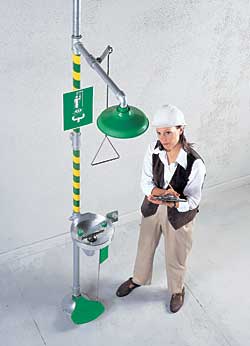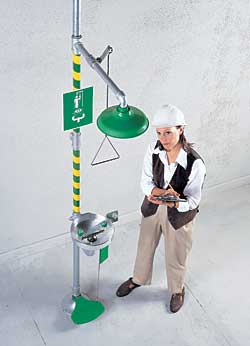
ANSI Z358.1 Compliance: Check Yourself Out!
It is estimated that the vast majority of multiple shower and/or eyewash installations in the United States still do not provide tepid water.
- By Casey Hayes
- Mar 01, 2007
 BACK in the days when it was acceptable to factor loss of life into
the planning for major public works projects such as dams and bridges,
compliance to safety standards was an afterthought. As personal safety
became more of a focus, those unsafe conditions gave way to
increasingly stringent current regulations and deviation penalties.
Today, there are very clearly defined operational safety protocols and
preparation requirements to deal with inevitable accidents due to
neglect or other circumstances.
BACK in the days when it was acceptable to factor loss of life into
the planning for major public works projects such as dams and bridges,
compliance to safety standards was an afterthought. As personal safety
became more of a focus, those unsafe conditions gave way to
increasingly stringent current regulations and deviation penalties.
Today, there are very clearly defined operational safety protocols and
preparation requirements to deal with inevitable accidents due to
neglect or other circumstances.
undefined
Compliance is not a once-a-year or once-a-month thing. It is an all-day, every-day requirement.
Availability of adequate first aid assets is a critical element ofthe plan for all significant businesses. And those assets are most
often regulated by OSHA, using ANSI's and other standards and
guidelines. The ANSI standard for emergency showers and eyewashes is
ANSI Z358.1, which was last revised in 2004. In its current
permutation, it is the clearest and most useful tool for preparing to
meet most workplace incidents.
While this discussion does not attempt to interpret Z358.1, it will
provide a checklist of sorts aimed at assisting readers in
understanding some of the significant requirements included in the
standard. We will provide a basic outline of some of the major elements
that must be met.
It should be understood that compliance is not a once-a-year or
once-a-month thing. Compliance is an all-day, every-day requirement.
Accordingly, emergency showers and eyewashes are required to be
activated weekly, with a more thorough evaluation on an annual basis.
This requirement is established in Sections 4.6.2, 4.6.5, and others.
Many companies today opt to have an outside, third-party inspection
performed for them annually, which provides an added measure of
credibility to the review process.
Beyond that, the following areas should be reviewed:
- Emergency showers, eyewashes, and combination
showers/eyewashes must be accessible within 10 seconds, must be on the
same level as the hazard, and the path of travel shall be free of
obstructions (Sections 4.5.2, 5.4.2, 6.4.2, 7.4.2).
- Emergency shower, eyewash, and combination shower/eyewash stations
should be designated by highly visible signage (Sections 4.2, 5.2, 6.2,
7.4.3) positioned so that the sign shall be visible in all areas served
by that specific equipment.
- Control valves on emergency showers, eyewashes, and combination
shower/eyewash equipment should be designed to enable them to be moved
from "off" to "on" in one second or less and to remain open until
intentionally closed (Sections 4.2, 5.2, 6.2, 7.2).
- Spray nozzle outlets on eyewashes and eye/face washes should be
protected from airborne contaminants when idle. Whatever means is used
to protect them should not require a separate motion (from equipment
activation) to remove the protection for equipment use (Sections 5.1.3,
6.1.3).
- Plumbed and self-contained eyewash equipment must be capable of
delivering flushing fluid to the eyes at a flow of not less than 1.5
liters per minute (.4 gpm) for the full, required, 15-minute irrigation
cycle (Sections 5.1.6, 6.1.6).
- For eyewashes, a means must be provided to ensure a controlled
flow of flushing fluid to both eyes simultaneously. (Section 5.1.1)
With respect to eye/face washes, the standard includes both eyes and
face (Section 6.1.6).
- There should be a minimum distance of 6 inches between the eyewash
outlet nozzles and any adjacent obstruction, such as walls, etc.
(Section 5.4.4).
- The proper height for eyewash or eye/face wash heads is between 33 inches and 45 inches above the floor (Section 5.4.4).
- Drench showers must deliver a minimum of 20 gpm flow (Section 4.1.4).
- The proper height for drench shower or combination drench shower
and eyewash shower heads is between 82 inches and 96 inches above the
floor (Section 4.1.2).
- Drench shower flow patterns should be a minimum of 20 inches wide at 60 inches above the floor (Section 4.1.5).
- There should be no barrier closer than 16 inches from the center
point of the installed emergency drench shower or combination shower
and eyewash (Section 4.1.5).
- Combination shower and eyewash equipment is subject to the same
individual component requirements, even when those components are used
simultaneously. That means, among other things, that flow and pattern
requirements for the shower and eyewash remain in effect during
simultaneous use. Sufficient pressure and volume of fluid to "drive"
both features is necessary (Section 7.4.4).
- Combination shower and eyewash equipment must be capable of
simultaneous use of the shower and eye or face wash by the same user
(Section 7.4.4).
- Flushing fluid must be tepid, which by the standard, established
guideline is between 60 degrees F and below 100 degrees F for the full
15-minute use cycle (Section 7.4.4).
Large Fines Are Common
There are obviously other requirements established by ANSI Z358.1,
but these are the most commonly overlooked or not followed. Every
month, there are published recaps of the OSHA violations processed and
the fines levied against companies that neglect to live by the
requirements. Fines are usually in the six-figure area! But aside from
the potentially punitive regulatory assessments that are possible,
there is the potential for negligence claims and litigation. The
company that was fined $213,000 last October for, among other things, a
"blocked eyewash" might have gotten off easy compared to having an
employee become permanently blinded due to that negligence.
Then there is the whole issue of tepid water, our final checklist
item above. The tepid water requirement has been in Z358.1 for some
time now. Prior to 2004, it was left to interpretation as to what was
the acceptable temperature range. In the 2004 revision, the standard
was clarified to provide the specifics outlined above. Tepid water is
essential to ensuring that an injured worker remains under the shower
or submersed into an eyewash for the full 15-minute use cycle. Cutting
short on the required time risks a less-than-complete removal of the
hazardous material, as well as failure to adequately cool the area
affected by, let's say, a chemical burn. Likewise, remaining in contact
with the water supplied by most municipal authorities for that time can
easily lead to hypothermia.
So the tepid water requirement is a solid one. However, it is
estimated that the vast majority of multiple shower and/or eyewash
installations in the United States still do not provide tepid water.
Forget about OSHA violations for a minute; think about it from the
standpoint of litigation by an employee after an accident. There is a
frightening amount of risk still out there in which the ANSI standard
could potentially be used as the proof for a negligence claim.
Today, providing emergency showers and eyewashes isn't enough. We
need to monitor their condition and the areas around them. Access and
useability are the keys. Is your equipment up to date? Are you
providing tepid water? Check yourself out or ask for an impartial,
third-party assessment.
This article appeared in the March 2007 issue of Occupational Health & Safety.
This article originally appeared in the March 2007 issue of Occupational Health & Safety.